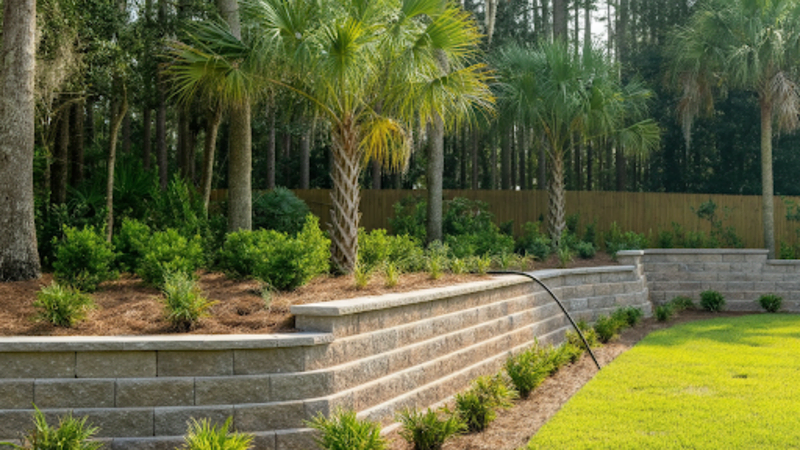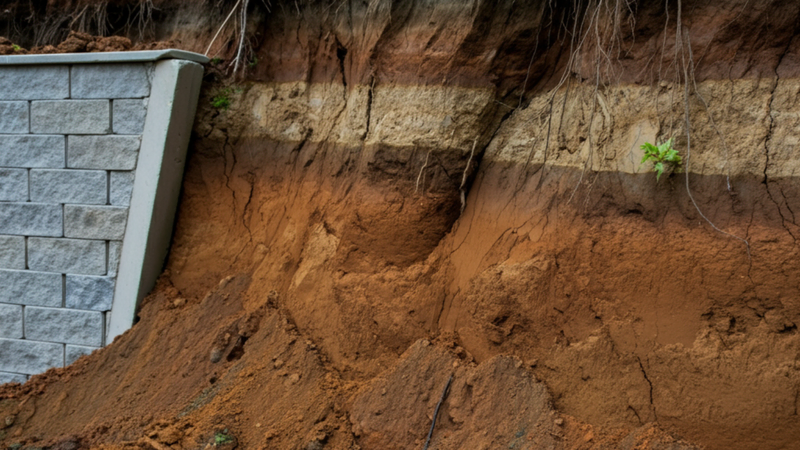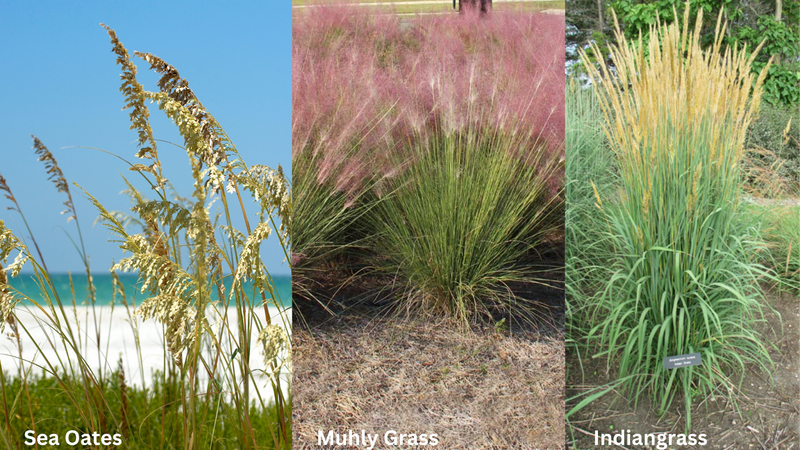
Retaining walls do more than just add structure to your yard—they protect your property and boost curb appeal. Built right, they help keep soil in place, manage drainage, and handle the wear and tear of Florida’s intense weather. A well-constructed retaining wall isn’t just a pretty feature—it’s a long-term investment in your landscape’s health.
But here’s the thing: without proper soil erosion control, even the best wall can be compromised. That’s especially true in the Florida Panhandle, where sandy soil, frequent rain, and fluctuating groundwater levels make erosion a serious issue. Let water build up behind the wall, and over time, it can shift the soil, damage the structure, and cost you big in repairs.
This guide is all about helping you prevent that. Whether you’re building a wall from scratch or trying to protect an existing one, we’ll walk you through practical steps to keep soil erosion in check. From smart material choices to drainage tips that work in our local climate, these proven strategies will help you create a strong, low-maintenance wall that lasts.
Whether you’re a weekend DIYer or a landscaping pro, you’ll find plenty of useful tips here to protect your property and keep your outdoor space looking its best.

Understanding Soil Erosion Behind Retaining Walls
What is Soil Erosion?
Soil erosion is what happens when natural forces—like rain, wind, or gravity—gradually wear away the top layer of soil. While it’s a natural process, it becomes a serious problem when it affects areas that need soil to stay put—like the space behind your retaining wall.
In many cases, soil erosion behind a wall is caused by poor water drainage. When water collects and has nowhere to go, it builds up pressure (called hydrostatic pressure) against the wall. Over time, this can push the soil out of place and even crack or shift the structure.
That’s why drainage isn’t just an add-on—it’s a must-have. Proper erosion control keeps the soil where it belongs and your wall standing strong.
Why Does It Happen Behind Retaining Walls?
There are a few common culprits when it comes to soil erosion behind retaining walls:
- Poor Drainage: If water gets trapped behind the wall, it builds pressure and weakens the structure.
- The Wrong Backfill: Loose or lightweight materials don’t stay in place and wash away easily.
- Weather Conditions: The Florida Panhandle is no stranger to heavy rain and hurricane season, both of which speed up erosion.
- Sandy Soil: Common in this region, sandy soil doesn’t hold together well, making it more likely to wash away when wet.
The Consequences of Unchecked Soil Erosion
Ignoring soil erosion issues can quickly lead to bigger problems, including:
- Cracks or collapse of the retaining wall
- Washed-out landscaping or garden beds
- Costly structural repairs or replacements
- A drop in your property’s value
Essential Strategies for Preventing Soil Erosion

1. Install Proper Drainage Systems
One of the biggest threats to any retaining wall is trapped water. When rainwater or irrigation runoff gets stuck behind the wall, it builds pressure—and that pressure can eventually cause cracks, leaning, or even total collapse. That’s why a solid drainage system is the first line of defense.
Here’s how to keep water moving where it should:
- Backfill with Gravel and Drain Pipes
Using gravel in your backfill creates space for water to flow freely. Add in perforated drain pipes (also called “French drains”) to carry excess water away from the wall. This combo is super effective at reducing pressure and keeping the soil in place. - Add Weep Holes
These small openings at the base of the wall act like release valves, letting trapped water escape naturally. When paired with good backfill and drain pipes, they help keep the wall dry and stable. - Use a Gravel Backfill
Instead of regular soil, go with gravel or crushed stone behind the wall. It drains well, doesn’t shift easily, and supports the wall’s structure—all while preventing erosion.
Why Drainage Matters in the Florida Panhandle
With the region’s heavy rains, high humidity, and often sandy ground, water management is especially critical. Without the right drainage system, your wall is at risk of flooding, shifting, or eroding faster than it should. Don’t take shortcuts here—this is one place where investing in good materials and installation really pays off.
🌊 Summit Tip: Work with a Local Expert
Florida’s soil and climate conditions are unique, so it’s smart to hire professionals who understand them—like our team at Summit Marine Development. We’ll make sure your wall is built to handle local weather, water levels, and code requirements.
2. Choose Suitable Backfill Materials
What you put behind your retaining wall matters just as much as the wall itself. The backfill—the material that fills the space between the wall and the soil it’s holding back—plays a huge role in drainage, stability, and erosion prevention.
If you use the wrong materials (like loose dirt or clay), water gets trapped, soil shifts, and your wall weakens over time. But if you choose the right materials? You’ll set your wall up for decades of strength and stability.
Best Backfill Materials for Florida Conditions
- Gravel or Crushed Stone
These are the top picks for a reason. They’re highly permeable, meaning water drains right through them instead of pooling. That takes the pressure off your wall and helps prevent erosion. They also stay in place better than loose soil, especially during Florida’s heavy rains. - Geotextile Fabrics
Think of these as high-tech soil support. These durable fabrics sit between the native soil and backfill, keeping the layers from mixing and strengthening the entire structure. They also improve drainage and reduce the risk of soil slipping through cracks in the wall. - Gravel + Sandy Soil Mix
In the Florida Panhandle, where sandy soil is the norm, a blended mix of gravel and local soil works wonders. This combo improves stability and water flow, keeping your base solid without stripping your landscape of native materials.
Why the Right Backfill Matters
Choosing high-quality, well-draining backfill materials helps:
- Control water flow
- Stabilize the wall
- Prevent long-term erosion
- Minimize future repairs
It’s one of the easiest ways to make sure your retaining wall lasts—and performs like it should.

3. Plant Vegetation and Ground Cover
Nature offers one of the most effective defenses against soil erosion—plant life. Using the right mix of vegetation can help anchor the soil, reducing water runoff and preventing erosion behind your retaining wall. Plus, it adds a burst of natural beauty to your landscape!
How Plants Help Control Soil Erosion
Plants, with their network of roots, stabilize the soil by holding particles together. Their leaves and stems slow down water as it flows over the surface, giving the soil time to absorb moisture rather than washing it away. Essentially, a healthy mix of plants acts like a living barrier that keeps soil erosion at bay.
Top Soil Erosion Control Plants for the Florida Panhandle
- Sea Oats: Perfect for sandy soils and coastal areas, sea oats have deep roots that secure loose soil and withstand strong winds.
- Indiangrass: This native grass thrives in various soil types and adds a natural, flowing look to any landscape. Its roots help keep the soil compact and sturdy.
- Muhly Grass: Known for its striking pinkish blooms, muhly grass not only looks beautiful but also efficiently prevents soil from shifting, even in dry conditions.
Tips for Enhancing Vegetation Benefits
- Combine with Mulch: Applying a layer of mulch, like wood chips or straw, can further reduce erosion. Mulch helps absorb excess water, lessening the impact of heavy rainfalls.
- Choose Native Species: Opt for plants native to the Florida Panhandle as they are best adapted to the local climate and soil, ensuring they grow strong and require less maintenance.
- Layer Your Planting: Use a mix of ground covers, shrubs, and deeper-rooted plants to create multiple layers of protection against erosion.
By blending functional and attractive vegetation, you not only secure your retaining wall but also transform your space into a greener, more inviting area.
4. Use Soil Erosion Control Fabrics
When you need a little extra reinforcement behind your retaining wall, soil erosion control fabrics—also called geotextiles —are a game-changer. These strong, breathable fabrics help lock soil in place while still letting water drain through, giving you both stability and protection.
How Do Soil Erosion Control Fabrics Work?
Geotextiles act like a hidden shield beneath the surface. They’re laid between soil layers or behind the wall itself, creating a barrier that stops soil from slipping or washing away during storms. At the same time, they allow water to pass through, reducing pressure behind the wall.
Think of them as a behind-the-scenes MVP for soil erosion control—doing the heavy lifting while staying completely out of sight.
Benefits of Using Soil Erosion Control Fabrics
- Keeps Soil in Place: Helps prevent soil from shifting or washing through gaps in your retaining wall.
- Improves Drainage: Allows water to pass through while keeping soil where it belongs, which minimizes pressure buildup.
- Adds Wall Stability: Works especially well in Florida’s sandy, erosion-prone soils, giving your wall extra support against the elements.
- Reduces Maintenance: Once installed, these fabrics work for the long haul with very little upkeep needed.
When to Use Them
Geotextile fabrics are especially useful in:
- Sloped areas
- Retaining walls with loose or sandy soil
- Projects where long-term erosion control is a top priority
Whether you’re installing a new retaining wall or reinforcing an older one, soil erosion control fabrics are an affordable and effective way to increase strength and durability—without compromising drainage.
5. Conduct Regular Maintenance and Inspections
A well-built retaining wall is designed to last, but even the strongest walls need regular checkups. Staying ahead of minor issues with simple maintenance can help you avoid major repairs down the road—and keep your wall doing its job beautifully for years to come.
Why Maintenance Matters
Retaining walls constantly battle the elements—especially in the Florida Panhandle, where rain, heat, and sandy soil can take a toll over time. Without proper care, small cracks or drainage issues can quickly turn into costly problems. A few minutes of routine maintenance can protect your investment and give you peace of mind.
Retaining Wall Maintenance Checklist
- Check Drainage After Rain: Inspect weep holes and drainage pipes to make sure they’re not blocked by dirt or debris. Poor drainage = pressure buildup.
- Look for Structural Red Flags: Watch for cracks, leaning sections, bulges, or pooling water—these are early warning signs of trouble.
- Reinforce Where Needed: If you see soil washing away or plants dying off near your wall, you may need to add more gravel, replace backfill, or replant vegetation.
- Clear Debris Regularly: Remove leaves, trash, and buildup that might block drainage or trap moisture.
Make It Part of Your Routine
You don’t need to be a pro to maintain your wall—just build it into your seasonal yard care routine. A quick inspection every few months (especially after big storms) can help you spot issues early and keep everything in top shape.
For larger or more complex walls, consider hiring a local expert like Summit Marine Development every few years for a professional inspection. We know what to look for and can help keep your wall structurally sound and soil erosion-resistant in the long term.
![]()
Avoiding Common Mistakes in Retaining Wall Construction and Maintenance
Even with the best intentions, mistakes can happen—especially if you’re building or maintaining a retaining wall without much experience. Some errors may seem small at first but can lead to major headaches (and costs) down the road.
Here are the most common pitfalls to watch out for—and how to avoid them.
1. Neglecting Drainage Systems
This is the number one cause of retaining wall failure. Without a reliable drainage setup, water builds up behind the wall, adding pressure that can lead to cracks, bulging, or collapse.
🌊 Summit Fix: Always include gravel backfill, drain pipes, and weep holes in your wall design—and keep them clear of debris.
2. Ignoring Local Building Codes
Building codes exist for a reason: to make sure structures like retaining walls are safe and long-lasting. Skipping permits or not following guidelines can lead to fines or having to redo the project entirely.
🌊 Summit Fix: Before you build, check with your city or county and follow the rules—or hire a licensed pro who already knows them.
3. Using the Wrong Backfill
It’s tempting to reuse dirt from your yard, but not all soil types are suitable. If the backfill doesn’t drain well or is too loose, it can put unnecessary strain on your wall.
🌊 Summit Fix: Choose gravel, crushed stone, or a gravel-sand mix for drainage and stability, especially in Florida’s sandy terrain.
4. Waiting Too Long to Address Soil Erosion
Minor signs of soil erosion can snowball into big structural problems if ignored. A little shifting here, some water pooling there—it all adds up fast.
🌊 Summit Fix: Take early signs seriously. Replant vegetation, add mulch, or adjust drainage before the damage gets worse.
5. Trying to DIY Complex Builds
Small, decorative garden walls? Go for it. But if your wall is over 3–4 feet tall or supporting a lot of soil, it’s best to call in the pros. Without proper engineering, your wall may not hold up.
🌊 Summit Fix: Hire licensed builders like Summit Marine Development who understand the local soil, weather, and engineering needs.

Professional Retaining Wall Services for the Florida Panhandle
When it comes to protecting your property from soil erosion and creating a lasting landscape feature, hiring a professional makes all the difference—especially in a region as unique as the Florida Panhandle.
At , we specialize in building retaining walls that are built to last. With years of hands-on experience, we understand the local soil, drainage challenges, and permitting requirements. Whether you’re dealing with sandy ground, high water tables, or storm runoff, we have the tools and know-how to get the job done right.
What Sets Us Apart
✔ Erosion Control Expertise: We don’t just build walls—we design them to stand strong against Florida’s toughest weather. From the right materials to proper water flow systems, everything we do is geared toward long-term erosion prevention.
✔ Custom-Built for Your Landscape: Your property is one of a kind, and your retaining wall should be too. We tailor each design to match your specific needs, whether you’re aiming for something functional, decorative, or both.
✔ Full-Service Solutions: From defining property boundaries to choosing backfill and installing drainage, we handle every detail. You’ll get a wall that’s structurally sound, code-compliant, and great-looking.
✔ Licensed and Insured: We’re fully licensed and insured for your peace of mind. We follow all local regulations to ensure that every project meets safety and quality standards.
Let’s Build Something That Lasts
At Summit Marine Development, we see every retaining wall as a chance to protect your investment and improve your outdoor living space. Whether you’re building new or upgrading an existing wall, we’re here to help with reliable advice, expert craftsmanship, and results that stand the test of time.
Ready to get started? Reach out today to schedule a consultation, and let’s talk about how we can build a stronger, safer, and more beautiful landscape together.
Build a Stronger, Safer Landscape
When it comes to protecting your yard and your investment, preventing soil erosion behind your retaining wall is essential—especially here in the Florida Panhandle. With frequent downpours, sandy soil, and shifting water tables, soil erosion can creep in fast and cause serious damage.
But the good news? You can take control.
By putting the right strategies in place—like installing solid drainage systems, using quality backfill, reinforcing with soil erosion control fabrics, planting native vegetation, and staying on top of maintenance—you can protect your property and extend the life of your retaining wall.
These aren’t just expert tips—they’re proven solutions that work with Florida’s landscape, not against it.
Partner With Local Experts You Can Trust
If you’re ready to build or upgrade a retaining wall that lasts, Summit Marine Development is here to help. We bring years of local experience, a deep understanding of soil erosion challenges in the Panhandle, and a commitment to quality in every project.
From start to finish, we’ll work with you to design a wall that’s not only tough and effective, but also complements your outdoor space beautifully. Let us take the stress out of retaining wall construction so you can focus on enjoying a landscape that’s secure, stylish, and built for the long haul.
Contact us today to learn more about our services and get started with a consultation. Together, we’ll build something that stands strong through every season.
![]()
Frequently Asked Questions (FAQs)
1. What materials are best for building retaining walls?
Retaining walls can be built using concrete blocks, natural stone, brick, timber, or poured concrete. The best material depends on your property’s needs, soil type, desired look, and budget. At Summit Marine Development , we help you choose materials that not only fit your style—but are also built to last in Florida’s climate.
2. How long does a retaining wall typically last?
With quality construction and regular care, retaining walls can last for decades. The lifespan depends on the material, how well it was built, and the environmental conditions it’s exposed to. That’s why it’s important to start with strong materials and a smart design.
3. How do I know if my retaining wall needs repair or replacement?
Look for warning signs like cracks, tilting, bulging, or pooling water behind the wall. These often point to structural issues or drainage problems. If you notice any of these, give us a call—we can inspect the wall and recommend the best course of action.
4. Can retaining walls help with drainage?
Absolutely. Many retaining walls are designed with built-in drainage features like weep holes, gravel backfill, and drain pipes. These systems help redirect water away from your property, preventing soil erosion and water damage.
5. How high can a retaining wall be built?
It depends on the soil conditions, load requirements, and local building codes. In most areas, walls over 4 feet may need engineering or reinforcement to stay safe and stable. We’ll make sure your wall is code-compliant and built for the long term—no guesswork involved.
